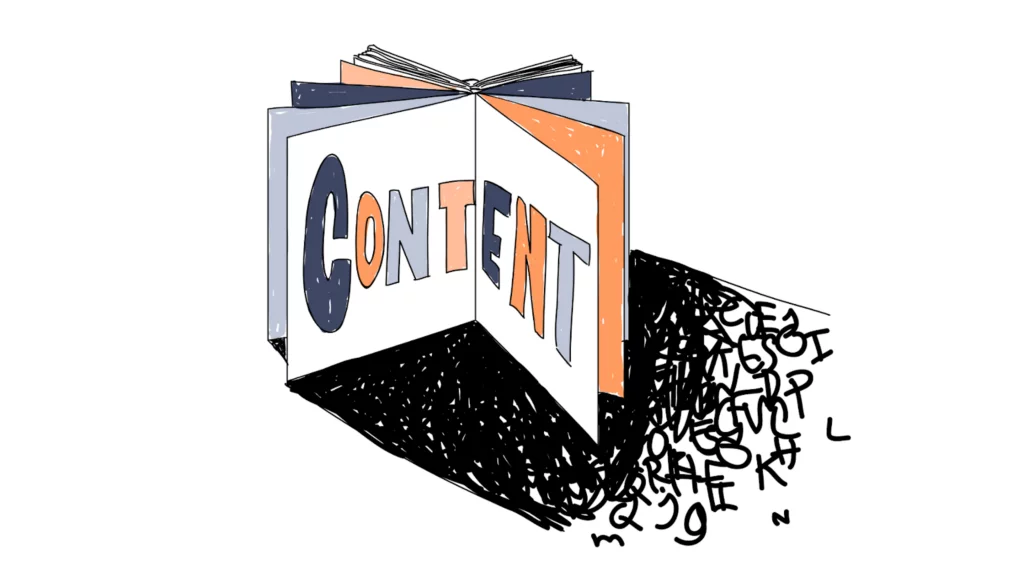
Content decay is a silent killer for organic growth and performance. It quietly undermines your gains and makes sustaining your revenue and organic traffic growth rate more challenging.
No matter how much fresh material you produce, if left unchecked, your overall organic traffic can eventually drop.
Once you know what content decay is, how to spot it, and how to remedy it, you can make it a truly interesting and useful component of your SEO content strategy.
A content strategy that targets your target keywords, incorporates a lot of evergreen content, and addresses content decay is crucial because over 4.4 million blog posts are published every day. This will ensure that your posts remain relevant and continue to bring in high-quality organic traffic to your website.
What Is Content Decay?
An ongoing drop in organic traffic and rankings for one or more blog posts is called “content decay.”
The phrase’s usage of the term “decay” is significant because it describes how the decline occurs. It doesn’t fall suddenly. A slow, steady decrease can cause cumulative losses if left unchecked over extended periods.
We can examine the phases of the content life cycle to gain a better understanding of this.
What leads to the content deletion on your website?
A website’s content may deteriorate due to several reasons. These are a few of the leading causes of deteriorating content:
Superior content from the competitors– It’s possible that they are using more thorough and beneficial content to target the exact keywords.
Reduced interest: There is a decrease in the frequency of searches for the keyword. A reduction in the volume of searches could occur for various causes.
Keyword cannibalism: Similar content on your WordPress blog that targets the same keyword may divide search traffic. It’s possible that Google won’t be able to determine the search intent and connect it to relevant material.
Shift in search intent: People’s motivations for using the keyword may have changed. For example, the user goal may have shifted from discussing various solar panel kinds on your page to purchasing one.
Search features: Google constantly modifies search results to better reflect user intent. Search traffic may be sent to featured snippets, shopping results, places, and other search features.
You must first identify which of your website’s content has deteriorated before determining what is causing it to do so.
Content Life Cycle

Step 1: Fresh Content Get Published
It takes time for a newly published piece to appear in Google Search results. It could take anywhere from six to eighteen months to observe any changes.
The difficulty of the term, level of competition, and authority of your website all affect how long it takes to rank. Search engine algorithms are now trying to figure out what your content is about and how it fits into the structure of your website.
Step 2: Rapid New Growth
If you optimize your website and content, you can get past the initial few months to a year-long growth phase. This is the point at which exponential growth begins.
As content rises in the ranks, it produces more backlinks and organic visitors. The more hyperlinks your article has, the more authority it has, and the higher it will stay on the search engine results pages.
Gaining additional backlinks is a beneficial cycle that can raise a website’s ranking on search engine results pages and strengthen its authority.
As content rises in the ranks, it produces more backlinks and organic visitors. The more hyperlinks your article has, the more authority it has, and the higher it will stay on the search engine results pages.
Gaining additional backlinks is a beneficial cycle that can raise a website’s ranking on search engine results pages and strengthen its authority.
Step 3: Reaches Peak Performance
Published works eventually reach a point of maximum expansion. These content ceilings have a few causes.
You can get fewer visits and backlinks if your content is outranked by a competitor’s post. The amount of traffic your post can produce is limited by the monthly search volume (MSV) for its primary keywords, even if it remains in the top spot.
Step 4: Content Decay Starts
Your content’s SEO performance may now reach a plateau and start to deteriorate gradually.
The article may lose ranking over time as it becomes less relevant or competitive, which will draw less attention from organic searches.
Even though decay is a natural occurrence, there are still steps you may take to prevent it. We’ll review five tactics you can apply to refresh content and raise its search engine ranks again.
5 methods to Fix Content Decay
Update outdated content frequently

This will assist in addressing concerns with content freshness, particularly for items with limited shelf lives. Examples of content include listicle posts with several screenshots, continually evolving information (such as tool features), and content that references dates (e.g., best email marketing techniques for 2023). Relevance for these kinds of articles equates to freshness, and search engines like Google want that.
Simple changes like updating the date on your title and meta description can constitute content updates. Altering the article entirely is another option. In either case, you should eliminate everything that ages the information to emphasize its value.
Expand

Expanding content refers to revising previous items that require further depth. The keyword and the amount of information needed to make your piece through will determine how much expansion is necessary. Updates to content could consist of a few hundred words or a thousand words.
Content consolidation

This could be an excellent chance to combine all of your content into a critical item if you have many little pieces that aren’t even ranking or if you have internal competition.
It is a somewhat nuanced decision whether to construct a new piece from scratch, drawing from the existing content, and incorporate everything into it or keep one piece as the main and incorporate others into it.
Consolidating content involves more than just setting up the proper 301 redirects from the previous URLs to the new main URL. Moving the content and having various locations that all go to the main post make it easier for the search engine algorithms to understand that you want the main article to be the one they index and care about.
Repromote outdated content

If you’ve recently updated, enlarged, or combined your older but valuable articles, a new round of marketing can make them buzz again. Resend outdated material to your email list, post it as fresh on social media, or use paid advertisements to increase attention.
You may build backlinks through social media presence and engagement, which is known to improve organic rankings.
As an additional strategy for boosting older content, consider guest posting. Contributing to other reputable websites is a great way to get backlinks to your material.
Focus more on evergreen content
The explanation is simple: they may withstand traffic for extended periods because they are more resilient. An article about “how to choose the best mattress for a 4-year-old” will stand the test of time. However, an additional list of the “ten best back-to-school essentials for teens” must be updated frequently.
Even though it’s not feasible to produce only evergreen content, make every effort to incorporate it into your content strategy plan. Evergreens simplify the process of managing your content library and require fewer modifications.
Conclusion
Content decay refers to online content’s diminishing relevance and effectiveness over time. In the ever-evolving digital landscape of 2024, staying ahead of content decay is crucial for maintaining visibility and engagement.
SEO and content marketing are not one-and-done endeavors. By being proactive, you can prevent problems like content degradation before they cause any harm or detect them as soon as they occur.
While some content decay is expected, you may prevent it by balancing adding new content and updating your archived materials.
Employing proactive strategies and embracing emerging trends can help content creators combat decay and keep their material fresh and impactful.
FAQs
How often should I update my content to avoid decay?
There’s no one-size-fits-all answer. Regularly assess your content’s performance and update as needed. Depending on your industry and content type, this could range from monthly to quarterly updates.
Is repurposing content an effective way to combat decay?
Yes, repurposing allows you to breathe new life into existing content. Transform articles into videos, podcasts, or infographics to cater to diverse audience preferences and extend the lifespan of your material.
Should I focus more on evergreen or trending content to combat decay?
A balanced approach is ideal. Create evergreen content for long-term relevance and incorporate trending topics to capitalize on current interests. This mix helps maintain a dynamic and enduring content strategy.
How can user-generated content help in combating decay?
Encouraging user-generated content fosters community engagement and provides a continuous stream of fresh material. User-generated content diversifies your content and builds a sense of community around your brand.
Are there any tools to help monitor content decay?
Various analytics tools and platforms like Google Analytics, SEMrush, and BuzzSumo can help monitor content performance. Regularly analyze metrics such as traffic, engagement, and keyword rankings to identify areas that need attention.
Is social media still relevant in combating content decay?
Absolutely. Social media platforms remain powerful tools for content distribution and audience engagement. Regularly share your content across platforms and actively participate in the discussions to stay connected with your audience.
How can I future-proof my content against rapid changes in technology?
Embrace emerging technologies and be adaptable. Stay informed about industry trends, invest in versatile content formats, and be ready to pivot your strategy as new technologies and platforms emerge.



